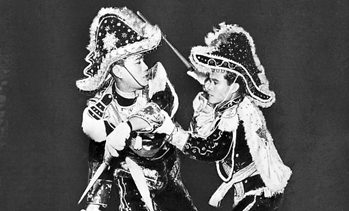Many arnisadors in the olden days saw the burgeoning of komedya as an added opportunity to practice martial arts. The nature of this new form of entertainment brought by the Spaniards offered the Filipinos a chance to use their martial arts within a new paradigm. Since the other purpose of the komedya is to serve as propaganda tool for Spain, its storyline was almost always about the triumphs of the Christians against the Moors.
Robert Mac Micking, one of the early Westerners who have written about the Philippines recorded his observations of the komedya in his book “Recollections of Manilla and the Philippines During 1848, 1849 and 1850,” it reads, “Besides the principal theatre, where Spaniards are the actors, there are two native theatres, where plays are represented in the Tagalog language, and written to suit their ideas of the drama; the subjects represented being principally tragedies connected with their historical traditions, and of their fathers’ earliest connections with their European conquerors.
But their mode of representing these subjects is scarcely suitable to any one’s taste but their own, as the amount of vociferation, and drawling singing of the women who take a part in the pieces, are very disagreeable, and the noise and quantity of fighting with which they are always interlarded, is tiresome. Yet, strange to say, they themselves are much interested while listening to these absurd recitatives.”
The dramatic battles between Christians and the Moors as portrayed in the komedya presented endless opportunities for arnisadores to showcase their fighting prowess. “The Columbia encyclopedia of modern drama, Volume 2” by Gabrielle H. Cody and Evert Sprinchorn cites specific plays employing lengthy fighting scenes, “Komedya scripts might depict the life of a patron saint as in the Play of Saint Michael (Comedia de San Miguel), written around 1890 and still staged in Iligan City. Popular stories showed the clash between Muslims and Christians.
An example is the komedya of St. Helena, which is performed in several towns of Nueva Ecija. It shows St. Helena seeking the true cross, while her son Constantino fights the Moors as a Moorish princess falls in love with a Christian general. After spectacular marches and battles, the defeated Moors convert and the lovers unite.”
While the komedya has provided the arnisadores of yore a new venue to exhibit their martial arts, it also surreptitiously served its original purpose of facilitating the complete conquest of a new land and its people.
Expounding on Nicanor Tiongson’s analysis of Filipino aesthetics via his essay “Four Values in Filipino Drama and Film,” Alicia Arrizón in her book “Queering Mestizaje: Transculturation and Performance,” wrote, “For instance, in the 1609 performance of El martirio de Santa Barbara (The martyrdom of Saint Barbara), the saint’s ascension to heaven and the subsequent destruction of those who had tortured her were aimed at convincing the natives to burn their amulets and the statues of their ancestral gods.
This piece was produced by the Jesuits in the southern province of Bohol and performed by the natives in their own language.”
The komedya enjoyed unsurpassed popularity during Spanish colonial times. An entry in “Mga Karunungan sa Larong Arnis [A Body of Knowledge in the Sport of Arnis]” by Placido Yambao and Buenaventura Mirafuente, the very first book written on arnis published by the University of the Philippines Press in 1957, states that agricultural production declined because of the men’s preoccupation with the stage plays where their prowess in arnis was displayed.
A portion of the book translated by anthropologist and arnis expert Felipe Jocano Jr. reads, “Because of the passion of the indio citizens of the Archipelago as well as some of the Christians to the pastimes of moro-moro and duplo, they practically devoted all their time night and day, to the practice and teaching of the participants in the moro-moro and duplo such that the farmers were neglecting to plow their fields, consequently, the Spanish Government forbade any form of recreation (Arnis and the Work of History, Rapid Journal Vol.9 No.2).”
While there is effort today in the Philippines to preserve the komedya, it is a rarity to chance upon plays whose fight scenes were played by skilled arnisadores.
There are some provinces though where this art form is still preserved and practiced. The province of Laguna, where the country’s National Hero Dr. Jose Rizal was born boasts of rich arnis and komedya traditions.
Rizal himself is an expert arnisador who taught the native martial art to young children during his exile in Dapitan. Traditional families in Laguna took pride in being komedya actors and arnisadores and these art forms are passed on from one generation to another.





















